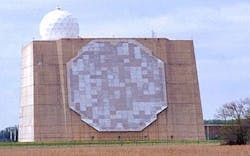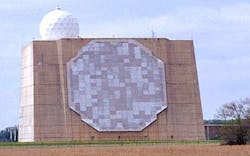Air Force eyes upgrades to PAVE PAWS, BMEWS, and PARCS ballistic missile warning radar
HANSCOM AFB, Mass., 1 Feb. 2012.Military radar experts at the U.S. Air Force Electronic Systems Center (ESC) at Hanscom Air Force Base, Mass., are reaching out to industry in the beginning of what may become a long-term project to modernize and upgrade three ageing ground-based ballistic missile warning radar systems -- PAVE PAWS, which is short for Phased Array Warning System; the Ballistic Missile Early Warning System (BMEWS); and the Perimeter Acquisition Radar Attack Characterization System (PARCS).
Air Force ESC officials have issued a request for information (solicitation number: 01262012) to identify defense companies that could oversee or contribute to systems upgrades and technology insertion for the PAVE PAWS, BMEWS, and PARCS ballistic missile early warning radar systems. Companies interested have until 23 Feb. to make their capabilities known.
The PAVE PAWS and BMEWS upgrades will involve technology refresh for the front-end and remoting capabilities of those radar systems. The PARCS upgrade project may require technology insertion for the back-end processing capabilities that will support front-end modernization. PAVE PAWS and BMEWS will have received significant upgrades to their data- and signal-processing subsystems by 2016 in separate efforts.
| Related stories -- BAE Systems military radar warning receiver to protect against anti satellite weapons -- Radar technology looks to the future -- Sensors make-or-break ballistic missile defense. |
PAVE PAWS is a ground-based radar system that provides U.S. Strategic Command (USSTRATCOM) at Offutt Air Force Base near Omaha, Neb., with warning and attack-assessment information on all intercontinental ballistic missiles (ICBMs) launched throughout the world that might be headed for U.S. territory.
BMEWS, meanwhile, is a ground-based radar system that helps warn USSTRATCOM and NATO authorities of submarine- and sea-launched ballistic missile (SLBM) attacks and provides data to help evaluate the severity of ballistic missile attacks.
PARCS is a large radar installation in North Dakota that provides ballistic missile warning and attack assessment, as well as space surveillance data to the North American Aerospace Defense Command (NORAD) Peterson Air Force Base, Colo., as well as to USSTRATCOM and regional combatant commanders. PARCS monitors and tracks more than half of all Earth-orbiting objects with its AN/FPQ-16 phased-array radar system pointed northward over Hudson Bay, and analyzes more than 20,000 tracks per day, from giant satellites to space debris.
PARCS was built in the early 1970s, and its signal processing has received only superficial fixes since the site went online in 1975. PARCS uses 1960s-era technology, which is not widely used, and few sources are available for depot-level repair on failed components, Air Force officials say.
The PAVE PAWS and BMEWS beam steering unit (BSU), receiver exciter (REX), receiver beam former (RBF), array group driver (AGD), radio frequency monitor (RFM), frequency time standard (FTS), and the corporate feed (CFD) were built for these five radars in the late 1970s and were upgraded in the 1980s, Air Force officials say. The REX and FTS already have been redesigned and upgraded at the Beale Air Force Base, Calif., Fylingdales, England, and Thule, Greenland sites as part of the Upgraded Early Warning Radar (UEWR) programs. They will be upgraded at the Clear, Alaska, and Cape Cod, Mass., sites by 2016 or 2017., officials say.
The PARCS signal processing group (SPG) consists of 10 cabinets of equipment with hundreds of unique parts. The SPG generates frequency-modulated pulses for transmission, spectrum inversion, and pulse compression; performs side lobe reduction; as well as compares and processes track signals, multiplexing, and signal conversion. Extensive alignment and maintenance are necessary to maintain proper signal reception and analog digital conversion, Air Force officials explain.
Air Force officials are asking for information from industry on ways to upgrade the system, and will use this information to define funding needs, technical approaches, and acquisition strategy.
Fundamental requirements involve maintaining the overall mission support capabilities of the existing system; minimizing system downtime during system replacement or modernization; and detecting and tracking objects per BMEWS and PAVE PAWS specifications.
Air Force officials particularly are interested in information on how to upgrade the radio frequency (RF) Front end of the early warning UHF radars to include hardware, software, and manufacturing, including design maturity Technology Readiness Level (TRL), development funding to TRL 6, cost estimates, and similar experience with phased array radar technology. The Air Force also is interested in concepts for operating the PARCS, PAVE PAWS, and BMEWS radars remotely.
E-mail responses no later than 23 Feb. 2012 to the Air Force's Curtis DeVries at [email protected]. For questions or concerns contact DeVries by e-mail.
More information is online at https://www.fbo.gov/spg/USAF/AFMC/ESC/01262012/listing.html.


